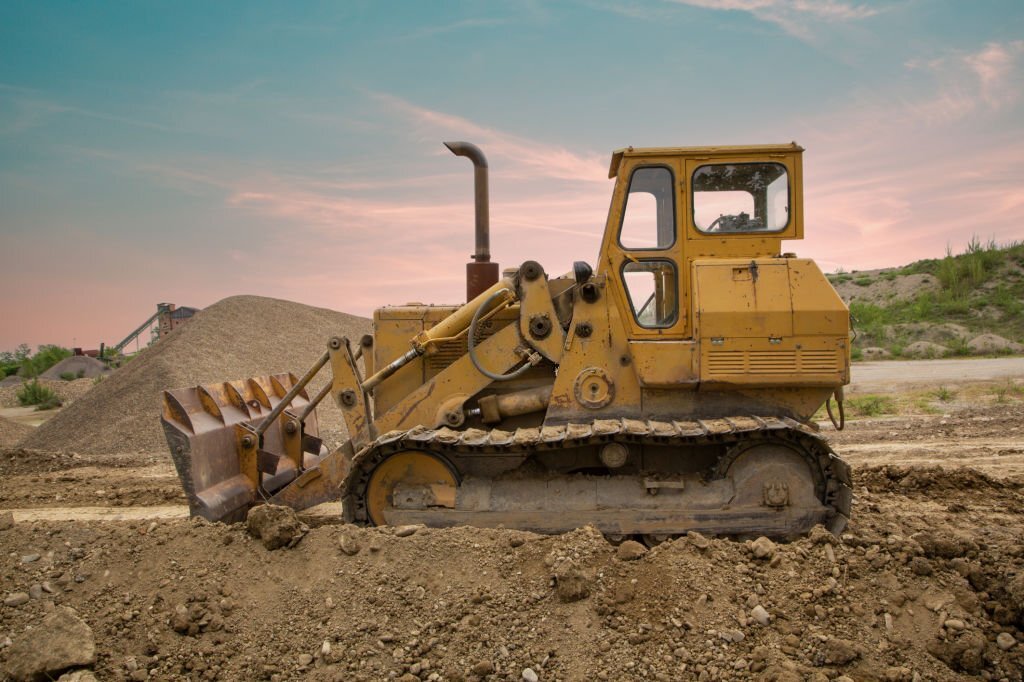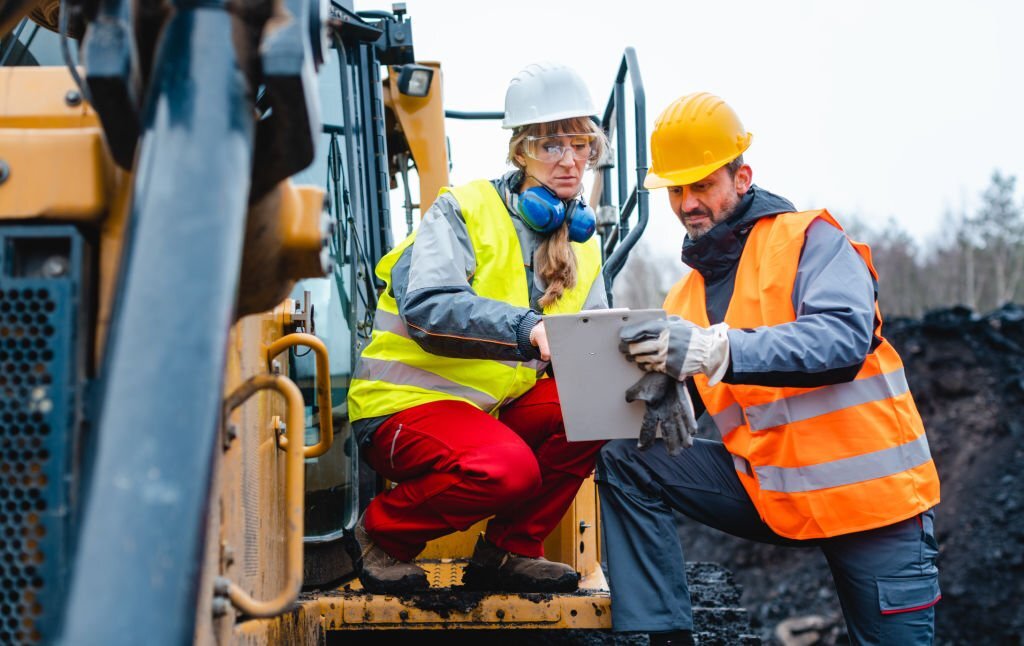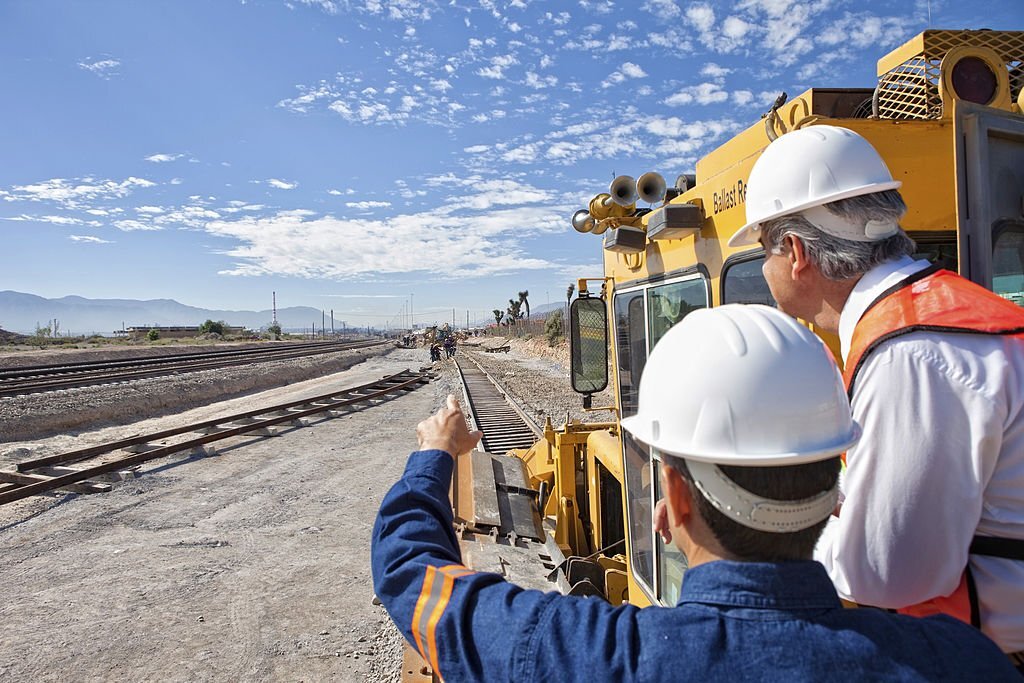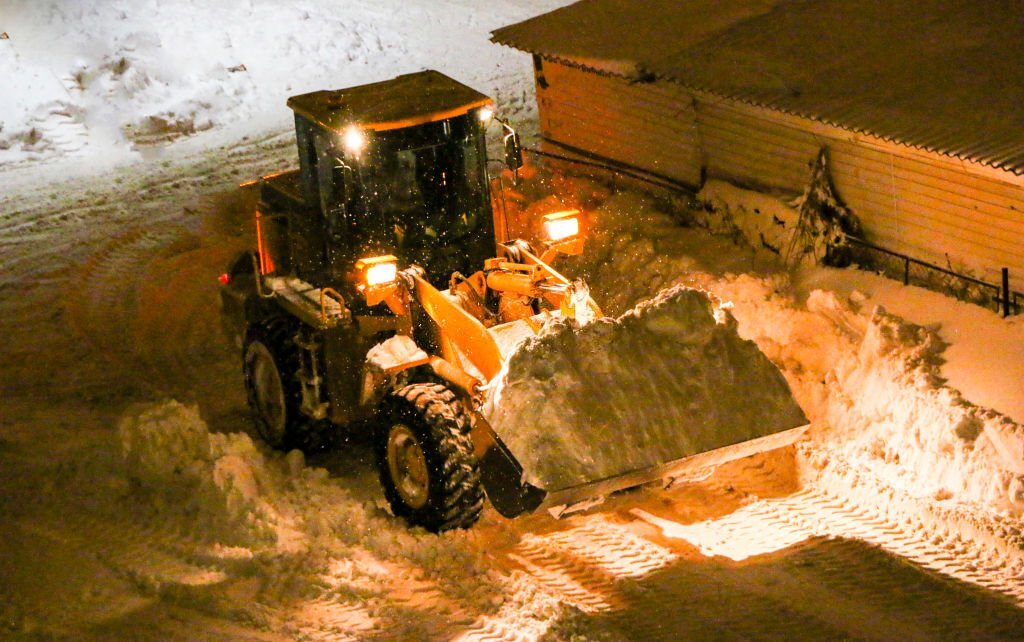
Bulldozers, with their immense power and robust build, have been an indispensable part of the construction industry for decades. These heavy-duty machines play a pivotal role in various construction projects, such as land clearing, site preparation, earthmoving, and road building.
A bulldozer typically consists of a large metal blade at the front that can be angled and tilted to push and move soil, debris, or other materials. With their exceptional versatility and strength, bulldozers have become a symbol of efficiency and productivity within the construction realm.
Definition of a Bulldozer and its Role in the Construction Industry
A bulldozer is a tracked or wheeled vehicle equipped with a powerful engine capable of generating substantial torque. This torque is transmitted to tracks or wheels to propel the machine forward or backward with ease across challenging terrains.
The most notable feature of a bulldozer is its front-mounted blade that can be raised or lowered hydraulically for various purposes. The blade’s angle can also be adjusted to optimize pushing efficiency.
In the construction industry, bulldozers are entrusted with multiple tasks due to their remarkable capabilities. They are commonly utilized for grading land surfaces by removing unwanted materials like rocks or vegetation.
Moreover, they excel in leveling the uneven ground before new structures are erected on top. Bulldozers also prove vital in creating access roads through tough terrains where conventional vehicles would struggle to navigate.
The Importance of Control Systems and Interfaces for Bulldozer Operators

Control systems and interfaces play an integral role in ensuring effective communication between operators and their machines. For bulldozer operators specifically, these systems become crucial in harnessing the full potential of these mighty machines while maintaining safety standards.
Given the complex operations involved in maneuvering a bulldozer’s blade accurately and efficiently, control systems provide operators with intuitive mechanisms to execute precise movements. They empower operators to control the blade’s lifting, tilting, angling, and other functions, allowing them to manipulate the terrain to meet the desired specifications.
Effective control systems enable operators to maintain a high level of productivity while minimizing errors and accidents. Furthermore, user-friendly interfaces streamline the operator’s interaction with the control systems.
Ergonomically designed interfaces enhance comfort during long working hours and reduce operator fatigue. Clear and intuitive displays ensure that operators have access to critical information about machine performance, fuel levels, diagnostics, and safety alerts at a glance.
By facilitating a seamless connection between operators and bulldozers, these control systems and interfaces contribute significantly to improving overall operational efficiency and operator satisfaction. In recent years, there has been considerable interest in developing innovative control systems and interfaces for bulldozers that offer enhanced features such as automation capabilities or augmented reality displays.
These advancements aim to improve precision, productivity, and safety standards while reducing complexity for operators. Excitingly, these developments hold great potential for revolutionizing how bulldozers are operated in construction sites globally.
Overview of Traditional Bulldozer Control Systems
Manual control levers and joysticks
Bulldozers have long relied on manual control levers and joysticks as the primary means for operators to maneuver these powerful machines. These control systems consist of a series of levers and a joystick strategically positioned within the operator’s reach.
Each lever corresponds to specific functions such as blade lift, tilt, direction, and speed control. The lever controls for blade lift and tilt is crucial in manipulating the bulldozer’s primary working tool, the blade or dozer attachment.
By pushing or pulling the appropriate levers, operators can raise or lower the blade to adjust its height or tilt it to achieve desired angles for efficient earthmoving operations. The direction control allows operators to steer the bulldozer either left or right, while speed control dictates the velocity at which the machine moves forward or backward.
Description of basic lever functions (e.g., blade lift, tilt, etc.)
The blade lift lever is responsible for raising and lowering the bulldozer’s blade. Usually located on the right side of the operator’s seat, pushing this lever forward raises the blade while pulling it back lowers it down. This functionality is vital when adjusting ground clearance or ensuring proper grading during construction projects.
Tilting refers to adjusting the angle of attack for more precise material manipulation. The lever responsible for this function is normally found on either side of the operator seat within easy reach.
Pushing it forward tilts the blade forward, making it easier to push material uphill, while pulling it back tilts it backward for controlled material retention when moving downhill. Additionally, there are separate levers dedicated to controlling bulldozer movement in different directions: forward/reverse travel and steering left/right using tracks rather than wheels found in conventional vehicles.
Limitations and challenges faced by operators

While traditional control systems have served bulldozer operators well, they do come with their share of limitations and challenges. One of the primary difficulties is the physical exertion required to operate these manual controls effectively.
The levers often demand substantial force to manipulate, resulting in operator fatigue over prolonged working periods. Moreover, the multitude of levers can be overwhelming for novice operators who need to quickly learn and master their proper utilization.
It takes time, practice, and experience to achieve optimal precision in blade movements and efficient control over the machine’s overall operation. In addition, manual control systems offer minimal feedback to operators regarding operational conditions.
This lack of information can impede decision-making on factors such as material resistance or potential obstacles. Furthermore, the absence of advanced features like automation hinders productivity by relying solely on operator skill levels.
Despite these challenges, traditional bulldozer control systems have been reliable workhorses for decades. However, with technological advancements on the horizon, innovative solutions are emerging to address these limitations and revolutionize how bulldozers are controlled—providing exciting prospects for both seasoned operators and those joining the industry anew.
Advancements in Bulldozer Control Systems

An Introduction to Innovative Control Systems and Interfaces
Bulldozer control systems have come a long way since the age of manual levers and joysticks. The advancements in technology have paved the way for innovative control systems and interfaces that revolutionize the way operators interact with these powerful machines.
These modern systems integrate electronic sensors, actuators, and automation features to enhance precision, efficiency, and overall operator experience. The integration of electronic sensors and actuators is a significant breakthrough in bulldozer control systems.
These advanced systems utilize sensors to gather data about various aspects such as blade position, ground conditions, engine performance, and more. By continuously monitoring these parameters, the control system can provide real-time feedback to the operator and make informed adjustments automatically.
For example, if a bulldozer encounters an obstacle while pushing soil, the sensor will detect the increased resistance and prompt the system to adjust blade pressure accordingly. This integration allows for smoother operation while reducing manual intervention required from operators.
Integration of Electronic Sensors and Actuators
The integration of electronic sensors plays a vital role in enhancing bulldozer control systems’ functionality. Sensors such as inclinometers measure machine inclination relative to gravity’s vertical axis or detect tilt angle changes during operation accurately.
These readings allow operators to maintain stability while working on uneven terrains or slopes by adapting blade angles and machine position accordingly. Additionally, pressure sensors embedded within the hydraulic system monitor hydraulic fluid levels and pressures, ensuring optimal performance while preventing potential damage to the system.
Actuators are crucial components that work in tandem with sensors to translate electronic signals into physical force or movement. Hydraulic actuators, for instance, control the movement of various parts of the bulldozer, including the blade and ripper.
By receiving signals from the control system based on operator inputs or automation algorithms, these actuators exert force or change positions precisely as required. This integration enables operators to have fine-grained control over their machines, improving efficiency and maneuverability.
Automation Features for Improved Precision and Efficiency
Automation features integrated into modern bulldozer control systems are transforming how these machines perform tasks with utmost precision and efficiency. Through advanced algorithms powered by machine learning and artificial intelligence (AI), these systems can analyze real-time data collected from sensors during operation. The analysis allows the automation algorithms to make informed decisions on optimizing bulldozer movements, blade angles, engine performance parameters, and other relevant factors.
For example, during grading operations where precise leveling is essential, an automated bulldozer control system can use input from ground surface sensors to adjust blade height automatically at predetermined intervals. This ensures consistent grading depth across the entire area being worked on without requiring constant adjustment by operators.
Similarly, automation features can also manage fuel consumption by optimizing engine performance according to workload demands or even implementing idle shutdown strategies when not in use for extended periods. These advancements not only improve operational efficiency but also enhance safety measures.
Automation reduces operator fatigue caused by continuous manual adjustments required in traditional control systems while allowing them to focus more on situational awareness and overall job execution. Additionally, automation minimizes human error in critical operations like maintaining a proper balance during steep slope work or preventing collision with obstacles through obstacle detection algorithms.
Advanced Control Interfaces for Bulldozers

Haptic Feedback Systems: Enhancing Operator Experience
In the quest for improved bulldozer control systems, engineers have turned to haptic feedback technology, revolutionizing the way operators interact with these powerful machines. Haptic feedback refers to the use of tactile sensations, such as vibration and force feedback, to provide users with a sense of touch and better situational awareness. In bulldozers, haptic systems are integrated into control interfaces, allowing operators to feel and interpret real-time information from the machine’s components.
By incorporating haptic technology into bulldozer controls, operators can experience a more intuitive and immersive connection with their machines. For instance, when manipulating the blade lift lever, haptic feedback can simulate resistance or vibrations that mimic the physical forces encountered during blade operation.
This not only provides operators with a better understanding of their machine’s response but also reduces cognitive load by allowing them to rely on their sense of touch rather than constantly looking at instrument panels or screens. The benefits of haptic feedback in enhancing operator experience extend beyond improved handling.
By providing tangible physical cues through vibrations or force feedback, it becomes easier for operators to detect variations in ground conditions or obstacles without diverting visual attention away from their surroundings. Ultimately, this leads to better situational awareness and increased safety on construction sites where bulldozers are extensively employed.
Augmented Reality (AR) Displays: A Window into Enhanced Situational Awareness
Imagine an operator peering through the window of a bulldozer cabin while being presented with an augmented reality (AR) display overlaying critical information on their field of view – this is precisely what AR displays offer in terms of advanced control interfaces for bulldozers. By utilizing AR technology, operators gain access to valuable real-time data overlaid onto their environment through smart glasses or head-mounted displays.
These AR displays can provide a wealth of information, including terrain maps, project blueprints, object detection alerts, and even virtual guides illustrating optimal blade angles or machine paths. By offering this additional layer of contextual information directly in the operator’s line of sight, AR interfaces enhance situational awareness and reduce cognitive load.
Gesture-Based Controls: Reducing Physical Strain for Bulldozer Operators
Gesture recognition technology has gained significant traction in various fields, including gaming and mobile devices – now it is making its way into bulldozer control systems as well. Gesture-based controls allow operators to interact with their machines through natural hand movements or gestures rather than relying solely on traditional physical levers or joysticks. This innovative approach not only offers a more intuitive user interface but also reduces physical strain on operators.
By mapping specific gestures to different commands or functions, operators can perform complex actions with precision while minimizing repetitive motions that may lead to fatigue or repetitive strain injuries. For example, a simple swipe gesture could activate the blade tilt function, while a pinching motion might engage the engine’s power boost feature.
Furthermore, gesture-based controls have the potential to improve productivity by reducing operator response times. With no need for manual adjustment of levers or switches, operators can seamlessly transition between tasks with quick and fluid gestures.
This streamlining effect translates into smoother operation cycles and increased overall efficiency on construction sites. Incorporating haptic feedback systems, augmented reality displays, and gesture-based controls into bulldozer control interfaces represents a paradigm shift in the way operators interact with these robust machines.
Through the integration of these advanced technologies, operators can enjoy enhanced precision, improved situational awareness, reduced physical strain, and ultimately greater productivity. As bulldozer control systems continue to evolve and embrace innovation, the future of construction machinery operation looks brighter than ever before.
Niche Innovations in Bulldozer Control Systems

Brain-Computer Interface (BCI): Unlocking the Potential of Direct Brain-Machine Communication
In the realm of cutting-edge control systems for bulldozers, one standout innovation is the brain-computer interface (BCI). This technology holds immense promise by enabling direct communication between the operator’s brain and the machine. BCI systems utilize electrodes placed on the scalp to detect and interpret brain activity, allowing operators to control various functions of the bulldozer without physical input.
The potential applications of BCI in future bulldozer control systems are vast. Imagine an operator effortlessly maneuvering a bulldozer through complex terrain simply by envisioning their desired movements.
With BCI, precision and efficiency can reach unprecedented levels as operators seamlessly translate their intentions into machine actions. Additionally, BCI technology has the potential to enhance operator safety by reducing physical strain and fatigue associated with manual controls.
Voice Recognition Systems: Empowering Bulldozer Operators Through Verbal Commands
Another noteworthy advancement in bulldozer control systems comes in the form of voice recognition technology. By harnessing this technology, operators can now utilize voice commands to control various aspects of bulldozer operations.
Voice recognition systems enable operators to communicate their instructions more efficiently and with greater ease, eliminating the need for manual input devices. The integration of voice recognition systems in bulldozers has significant implications for operator safety.
By reducing reliance on physical controls, operators can keep their hands on essential components such as steering wheels or emergency stop switches at all times. Voice commands also minimize distractions caused by looking away from crucial areas ahead while operating a powerful machine like a bulldozer.
Conclusion
As we delve into the realm of innovative control systems and interfaces developed for bulldozer operators, it becomes evident that exciting advancements are on the horizon. The advent of brain-computer interfaces (BCI) opens up endless possibilities for direct brain-machine communication, revolutionizing how bulldozers are operated. By harnessing the power of BCI, operators can control machines with their thoughts, enhancing precision and reducing physical strain.
Furthermore, voice recognition systems offer an alternative input method that empowers operators to operate bulldozers through simple verbal commands. This technology not only improves efficiency but also enhances operator safety by minimizing distractions and allowing for continuous focus on essential tasks.
As we look ahead to the future, it is clear that these niche innovations in bulldozer control systems will continue to evolve and shape the construction industry. With improved precision, efficiency, and operator safety at the forefront of these developments, we can remain optimistic about a future where bulldozer operators have advanced tools at their disposal to maximize productivity while ensuring their well-being.

